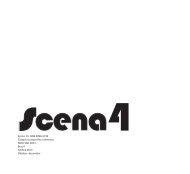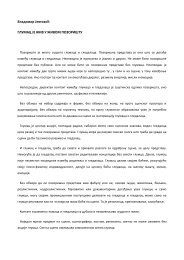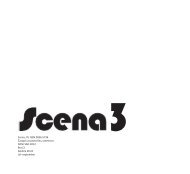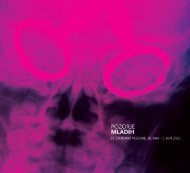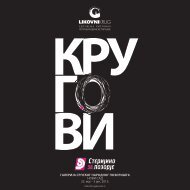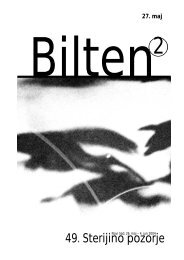Marco de Marinis The Actor is Dead, Long Live the Actors! Current ...
Marco de Marinis The Actor is Dead, Long Live the Actors! Current ...
Marco de Marinis The Actor is Dead, Long Live the Actors! Current ...
- No tags were found...
Create successful ePaper yourself
Turn your PDF publications into a flip-book with our unique Google optimized e-Paper software.
Sanzio) often skip <strong>the</strong> actor as a creative subject and expressive presence, dividing <strong>the</strong>mselves to twoopposed typologies of production: performances-images and performances-installations on <strong>the</strong> one hand,i.e. purely v<strong>is</strong>ual and multi-media creations in which <strong>the</strong> actor, if he survives, <strong>is</strong> simply reduced to an image,an icon, body-soma, and, on <strong>the</strong> o<strong>the</strong>r hand, concerts in which <strong>the</strong> actor <strong>is</strong> essentially a voice.A young Italian critic, looking back at ep<strong>is</strong>o<strong>de</strong> IX (Marseille, 2004) of <strong>the</strong> cycle Tragedia Endogonidaperformed by Societas Raffaello Sanzio, correctly spoke about <strong>the</strong> bor<strong>de</strong>r experience against <strong>the</strong> traditionof <strong>the</strong> actor in <strong>the</strong> 20 th century. [...] <strong>The</strong> process [which] ultimately d<strong>is</strong>charges <strong>the</strong> actor of <strong>the</strong> urgent andnecessary status in favour of rhythmic modulation [baluginio] of lights and sounds. 9More recently, Silvia Mei, ano<strong>the</strong>r representative of <strong>the</strong> young critique, referring to <strong>the</strong> groups of <strong>the</strong>last generation (Muta Imago, Orthographe, Città di Ebla, Santasangre, Zaches Teatro, Teatro Persona,Anagoor etc.) wrote: <strong>The</strong>se young groups have openly asked questions against <strong>the</strong>atre, because <strong>the</strong>ybelong to <strong>the</strong> areas of v<strong>is</strong>ual and fine arts, vi<strong>de</strong>o technologies. <strong>The</strong> notion of <strong>the</strong> actor has experienced atransformation in or<strong>de</strong>r to <strong>de</strong>fine itself in <strong>the</strong> light of philosophical terms Figure, Simulacrum, Soma. <strong>The</strong>traditional performance frame has experienced a rupture due to <strong>the</strong> suggestion of new strategiesconcerning action and non-action by establ<strong>is</strong>hing a d<strong>is</strong>positive harmon<strong>is</strong>ed with v<strong>is</strong>ion ra<strong>the</strong>r than look. Weare witnessing <strong>the</strong> doubling of figurative and v<strong>is</strong>ual power of stage, which <strong>is</strong> becoming a hyperstage, thanksto <strong>the</strong> support of technologies and/or <strong>de</strong>velopped skills. Through <strong>the</strong> actor or in spite of <strong>the</strong> actor, th<strong>is</strong>hyperstage multiplies itself, moves and transforms. 10Starting from <strong>the</strong> examples of th<strong>is</strong> type (which can be compared, I think, to <strong>the</strong> rest of <strong>the</strong> world),<strong>the</strong>re <strong>is</strong> a great temptation (which I could not res<strong>is</strong>t a few years ago) 11 to speak about a trueep<strong>is</strong>temological cut in <strong>the</strong> way in which <strong>the</strong> last generations are thinking and <strong>de</strong>aling with <strong>the</strong>are. In th<strong>is</strong>cut, an important role was played by technological innovation, from multi-media to hyper-media, with anirruption of new media and <strong>the</strong> digital. Still, its foundation plunges into <strong>the</strong> mentality or, in th<strong>is</strong> case, intoculture and <strong>the</strong> imaginary of <strong>the</strong> young <strong>the</strong>atre generation. Th<strong>is</strong> rupture enables us to use again an almostforgotten term, which fell into d<strong>is</strong>repute, and that <strong>is</strong> “representation,” by giving it new semantics, originalin relationship to <strong>the</strong> past, thanks to <strong>the</strong> erasure of th<strong>is</strong> lexeme from almost <strong>the</strong> entiredramatic/fictional/expressive and its anchoring in <strong>the</strong> essentially art<strong>is</strong>tic/v<strong>is</strong>ual problems, with crucial termssuch as “image” or “figure,” as we have already seen.Still, one should not general<strong>is</strong>e too much. What I have just said concern only one area of <strong>the</strong> new art<strong>the</strong>atre, <strong>the</strong> one in which <strong>the</strong> rupture and d<strong>is</strong>continuity between <strong>the</strong> 20 th and <strong>the</strong> 21 st century <strong>is</strong> clearer. But9F. Acca, L'attore e il suo dopo, “Culture Teatrali”, 13, cit., p. 34.10S. Mei, “La nouvelle vague du théâtre italien: le <strong>de</strong>rnier défi pour un théâtre iconographique,“ presented at<strong>the</strong> International Conference “Surmarionnettes et mannequins: Craig, Kantor et leurs héritages contemporains”(Charleville-Mézières, 15-17 mars 2012), <strong>the</strong> collection <strong>is</strong> currently in print.11M. De <strong>Marin<strong>is</strong></strong>, Dopo l'età d'oro..., quoted, pp. 16 and <strong>the</strong> following.
etween writing and speaking. <strong>The</strong> actor solo<strong>is</strong>t <strong>is</strong> still usually a textual actor (actor-who-reads or actorwho-recites-a-text).Quite differently, <strong>the</strong> actor storyteller works on oral skills, improv<strong>is</strong>ation, even when hebases himself on <strong>the</strong> pre-ex<strong>is</strong>ting text. Moreover, he usually “exposes h<strong>is</strong> unchangeable i<strong>de</strong>ntity on <strong>the</strong>stage 13 “, i.e. he does not act, he does not become a character, perhaps only rarely and temporarily, heactually tells a story. In Italy, <strong>the</strong> names are those of Moni Ovadia, <strong>Marco</strong> Paolini, <strong>Marco</strong> Baliani, AscanioCelestini, Davi<strong>de</strong> Enia, Mario Perrotta, Mimmo Cuticchio and many o<strong>the</strong>rs.Social actor (or actor of diversity). Un<strong>de</strong>r <strong>the</strong> term social actor of actor of diversity, I mean <strong>the</strong> onewho acts in <strong>the</strong> so-called social <strong>the</strong>atres, i.e. <strong>the</strong>atres that <strong>de</strong>al with <strong>the</strong> domain of uneasiness (physical andmental) and marginal<strong>is</strong>ation. Here I am thinking both about non-actors, i.e. pr<strong>is</strong>oners, <strong>the</strong> handicapped,immigrants, political refugees, etc. And professional <strong>the</strong>atre workers, actors, directors, authors etc. whochoose to work in difficult situations, showing how social effectiveness (even <strong>the</strong>rapeutic sometimes) andart<strong>is</strong>tic quality are tightly connected, help and support each o<strong>the</strong>r. It <strong>is</strong> sufficient to mention Pippo Delbonoand h<strong>is</strong> true star Bobo, who belong to <strong>the</strong> troupe Compagnia <strong>de</strong>lla Fortezza (compr<strong>is</strong>ed from <strong>the</strong> <strong>de</strong>taineesof <strong>the</strong> pr<strong>is</strong>on Volterre in Tuscany, gui<strong>de</strong>d by Armando Punzo), or in Europe La Compagnie <strong>de</strong> l'O<strong>is</strong>eauMouche and Candoco Dance Company.<strong>The</strong> social actor as a form of transformation of <strong>the</strong> contemporary actor reminds us, on <strong>the</strong> one hand,of an incredible social/anthropological effectiveness of <strong>the</strong>atrical techniques (or ra<strong>the</strong>r of primary <strong>the</strong>atre),but it enables us, on <strong>the</strong> o<strong>the</strong>r hand, to d<strong>is</strong>cover new and unthinkable forms of art and beauty: even better,it forces us to notice and recogn<strong>is</strong>e <strong>the</strong>m when laziness, conformity and fear are thwarting us: in <strong>the</strong>diverse, <strong>the</strong> o<strong>the</strong>r, elsewhere. By doing th<strong>is</strong>, <strong>the</strong> social actor carries out an unedited revival of <strong>the</strong>atreconceived as practice of alterity.Mixed <strong>Actor</strong>. I prefer to talk about a mixed actor than to use o<strong>the</strong>r terms used more often, like amulti-ethnic of inter-cultural actor, because th<strong>is</strong> term – mixed – allows me to better con<strong>de</strong>nse <strong>the</strong> featurescharacter<strong>is</strong>tic for th<strong>is</strong> form of <strong>the</strong> post-20 th century actor.In fact, <strong>the</strong> mixed actor <strong>is</strong> nei<strong>the</strong>r exclusively nor principally <strong>the</strong> actor who works in multi-ethnic andinter-cultural environments, i.e. with actors and viewers who belong to different cultures, languagecommunities, civil<strong>is</strong>ations (as in <strong>the</strong> case of <strong>the</strong> pioneer and now classic troupe of Peter Brook and Bouffesdu Nord and Théâtre du Soleil by Ariane Mnouchkine in Par<strong>is</strong>, or, in Italy, Teatro <strong>de</strong>lle Albe <strong>de</strong> Ravenna withits mixture between actors from <strong>the</strong> region Romagna and young immigrants from Senegal).In my meaning of <strong>the</strong> term, <strong>the</strong> mixed actor <strong>is</strong> <strong>the</strong> one who art<strong>is</strong>tically and dramatically works onh<strong>is</strong>/her own intercultural/multiethnic elements, i.e. on multi-layered i<strong>de</strong>ntities and internal cultural13G. Guccini, “Teatro e narrazione: nuova frontiera <strong>de</strong>l dramma,“ in Il Novecento: Un secolo di cultura: Italia eUngheria, eds. I. Fried and E. Baratono, Budapest, ELTE TKF, 2002, p. 219.
Since <strong>the</strong> ’80s, Grotowski speaks about “performer” instead of “actor”, in or<strong>de</strong>r to refer to <strong>the</strong> workof <strong>the</strong> actor outsi<strong>de</strong>, after, without <strong>the</strong> performance, in essence to <strong>the</strong> work on oneself and <strong>the</strong> effects heproduces on those who gui<strong>de</strong> him, in terms of energetic transformations or, according to preferences, ofchanges to <strong>the</strong> states of consciousness or mo<strong>de</strong>s of perception.It <strong>is</strong> a complex and and fascinating subject Grotowski <strong>de</strong>veloped after 1986, un<strong>de</strong>r <strong>the</strong> title “Art asVehicle” by creating Workcenter <strong>de</strong> Pente<strong>de</strong>ra, with <strong>the</strong> perfection of <strong>the</strong> exerc<strong>is</strong>e Motions and above all afew performances un<strong>de</strong>r <strong>the</strong> title “Action”, <strong>the</strong> work continued after <strong>the</strong> work of <strong>the</strong> Pol<strong>is</strong>h master in 1999by Thomas Richards and Mario Biagini: Downstairs Action, Action, An Action in Creation, <strong>The</strong> Letter.<strong>The</strong> recent results of <strong>the</strong> work of Workcenter <strong>de</strong> Ponte<strong>de</strong>ra, above all <strong>the</strong> ones started in 2008 with<strong>the</strong> birth of two different teams lead by Richards and Biagini, show how m<strong>is</strong>leading <strong>the</strong> impressions causedby <strong>the</strong> final separation of Art as Vehicle from <strong>the</strong>atre were, and thus <strong>the</strong> performer from <strong>the</strong> actor: DiesIrae, <strong>The</strong> Letter, but mostly <strong>The</strong> Living Room created by Richard’s team, and I am America after Ginsberg,created in Biagini’s team, do not represent at all a pure and simple return to performance in <strong>the</strong> sense ofdirection change or even rejection. On <strong>the</strong> contrary, <strong>the</strong>y represent a very interesting example of post-20 th -century transformation of <strong>the</strong>atrical performance and i<strong>de</strong>ntity/function of <strong>the</strong> actor, an example turned tofuture that will be analysed for a long time.Instead of using <strong>the</strong> term performer in its generic and weak sense, or, on <strong>the</strong> contrary, to r<strong>is</strong>k andproduce a prec<strong>is</strong>e type of actor (of anti-actor, in fact), we should ra<strong>the</strong>r, according to my opinion, recogn<strong>is</strong>e<strong>the</strong> significance of <strong>the</strong> performative dimension in contemporary <strong>the</strong>atre and in <strong>the</strong> manner in whichdifferent aspects of actorial transformation I talked about function.I am not even sure one should even speak about <strong>the</strong> “performance <strong>the</strong>atre” as Josette Féral does,but on <strong>the</strong> contemporary stage <strong>the</strong> dialectic between <strong>the</strong>atralicality and performance, which <strong>the</strong> Canadianresearcher has come up with <strong>is</strong> very important. For <strong>de</strong>ca<strong>de</strong>s we have been witnessing <strong>the</strong> phenomenon onecould call performativ<strong>is</strong>ation of <strong>the</strong>atre, which d<strong>is</strong>members <strong>the</strong>atre into several levels, from dramaturgy todirecting, acting. In that sense, we can d<strong>is</strong>tingu<strong>is</strong>h at least three principal processes:1) (variable) prevalence of <strong>the</strong> dimension of presence, self-reflexive exposition, self-significantmateriality, return to <strong>the</strong> self, respect for <strong>the</strong> dimension of representation, fiction, narration,return to <strong>the</strong> o<strong>the</strong>r than one self;2) Ten<strong>de</strong>ncy toward <strong>de</strong>construction (to a variable extent) of <strong>the</strong> drama form and <strong>the</strong> directing form,through <strong>the</strong> use of d<strong>is</strong>positives which are, in <strong>the</strong> end, <strong>the</strong> same as Lehmann <strong>de</strong>fined <strong>the</strong> postdramatic:paratax<strong>is</strong>, simultaneity, play with <strong>the</strong> <strong>de</strong>nsity of signs, music directing, v<strong>is</strong>ual
dramaturgy, corporality, irruption of reality, event/situation; but also: fragmentation,incompleteness, d<strong>is</strong>continuity.3) Rethinking of <strong>the</strong> <strong>the</strong>atrical peformance no longer in terms of work/product, but in terms ofevent and relation, character<strong>is</strong>ed by physical co-presence of <strong>the</strong> actor and spectator and byenergetic exchange between <strong>the</strong> two, and <strong>the</strong>refore by corporality as an essential dimension forone or <strong>the</strong> o<strong>the</strong>r.In connection to th<strong>is</strong>, and to conclu<strong>de</strong>, <strong>the</strong> <strong>de</strong>finition of performance proposed by Marina Abramovićwould perhaps be interesting:“<strong>The</strong> <strong>de</strong>c<strong>is</strong>ive aspect of performance <strong>is</strong> <strong>the</strong> direct relationship to <strong>the</strong> audience, <strong>the</strong> transm<strong>is</strong>sion ofenergy between <strong>the</strong> audience and <strong>the</strong> performer. What <strong>is</strong> performance? It <strong>is</strong> a kind of physical and mentalconstruction with which <strong>the</strong> art<strong>is</strong>t faces <strong>the</strong> audience. [...] Performance <strong>is</strong> a direct transm<strong>is</strong>sion ofenergy 19 .“19M. Abramovič, Body Art, in Marina Abramovič, Milano, Edizioni Charta, 2002, p. 13.



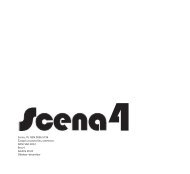
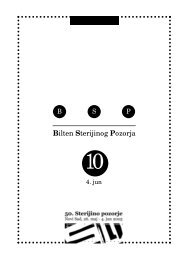
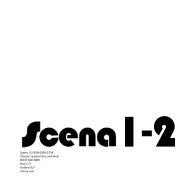
![neboj[a rom^evi] karolina nojber](https://img.yumpu.com/43476260/1/185x260/neboja-romevi-karolina-nojber.jpg?quality=85)
